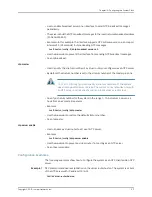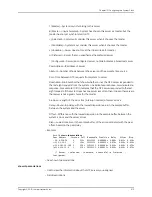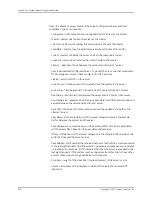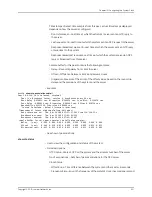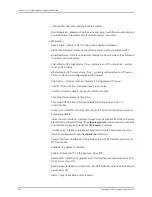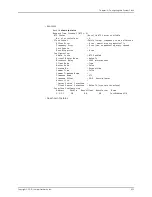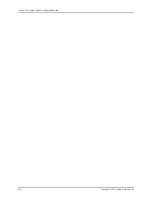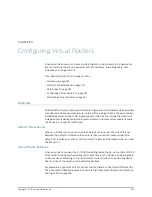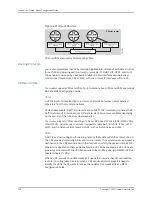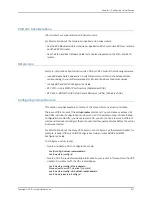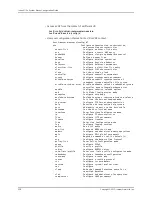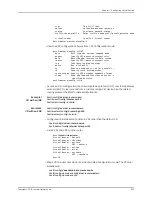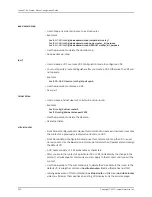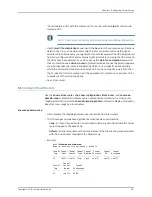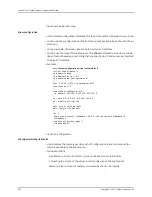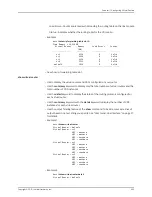
“Cannot delete a VRF with this command.” You must use the
no ip vrf
command to
remove a VRF.
NOTE:
See the JunosE Command Reference Guide for additional information.
•
Use the
wait-for-completion
keyword with the
no
version if you require a synchronous
deletion of a VR, such as when executing Telnet or console commands through an
external script. Alternatively, you might want to use this keyword if the VR being deleted
has many configured VRFs and someone might attempt to re-create the VR before all
the VRFs have been deleted. If you do not issue the
wait-for-completion
keyword in
those circumstances, a
virtual-router
command issued as soon as the prompt appears
could fail because the router is still deleting VRFs. You can specify a period during
which the CLI waits before it returns a prompt. If you do not specify a wait time, then
the CLI does not return a prompt until the operation is complete. You can press Ctrl+c
to break out of the wait period early.
•
See virtual-router.
Monitoring Virtual Routers
Use the
show virtual-router, the show configuration virtual router ,
and
show aaa
domain-map
commands to display virtual router and user-domain-to-virtual-router
mapping information. Use the
show ip forwarding table
command to display information
about memory usage by virtual routers.
show aaa domain-map
•
Use to display the mapping between user domains and virtual routers.
•
The following keywords have significance when used as user domains:
•
none
—All client requests with no user domain name are associated with the virtual
router mapped to the
none
entry
•
default
—All client requests with a domain present that has no map are associated
with the virtual router mapped to the
default
entry
•
Example
host1#
show aaa domain-map
Domain: boston; virtual-router: default
Tunnel Tunnel Tunnel Tunnel Tunnel Tunnel Tunnel Tunnel
Tag Peer Source Type Medium Password Id Hostname
------ ------ ------ ------ ------ -------- ------ --------
31 <null> <null> l2tp ipv4 <null> <null> <null>
Tunnel
Tunnel Server Tunnel
Tag Name Preference
------ ------ ----------
31 <null> 2000
531
Copyright © 2010, Juniper Networks, Inc.
Chapter 11: Configuring Virtual Routers
Summary of Contents for JUNOSE 11.3
Page 6: ...Copyright 2010 Juniper Networks Inc vi...
Page 8: ...Copyright 2010 Juniper Networks Inc viii JunosE 11 3 x System Basics Configuration Guide...
Page 24: ...Copyright 2010 Juniper Networks Inc xxiv JunosE 11 3 x System Basics Configuration Guide...
Page 32: ...Copyright 2010 Juniper Networks Inc 2 JunosE 11 3 x System Basics Configuration Guide...
Page 146: ...Copyright 2010 Juniper Networks Inc 116 JunosE 11 3 x System Basics Configuration Guide...
Page 166: ...Copyright 2010 Juniper Networks Inc 136 JunosE 11 3 x System Basics Configuration Guide...
Page 432: ...Copyright 2010 Juniper Networks Inc 402 JunosE 11 3 x System Basics Configuration Guide...
Page 488: ...Copyright 2010 Juniper Networks Inc 458 JunosE 11 3 x System Basics Configuration Guide...
Page 524: ...Copyright 2010 Juniper Networks Inc 494 JunosE 11 3 x System Basics Configuration Guide...
Page 554: ...Copyright 2010 Juniper Networks Inc 524 JunosE 11 3 x System Basics Configuration Guide...
Page 566: ...Copyright 2010 Juniper Networks Inc 536 JunosE 11 3 x System Basics Configuration Guide...
Page 588: ...Copyright 2010 Juniper Networks Inc 558 JunosE 11 3 x System Basics Configuration Guide...
Page 613: ...PART 3 Index Index on page 585 583 Copyright 2010 Juniper Networks Inc...
Page 614: ...Copyright 2010 Juniper Networks Inc 584 JunosE 11 3 x System Basics Configuration Guide...
Page 632: ...Copyright 2010 Juniper Networks Inc 602 JunosE 11 3 x System Basics Configuration Guide...

